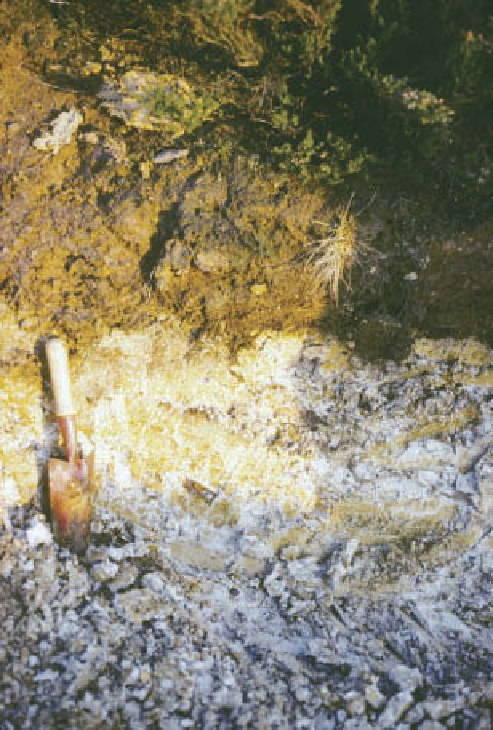Geoscience Reference
In-Depth Information
Plate 23.15
Biogeographers analyse fossil pollen to
reconstruct past vegetation. Pollen grains are extracted from
peat or sediment, stained by safranin dye, and identified under
the microscope at about 400
magnification. The prominent
grain lower-centre is grass (Gramineae) and is about 30
acetellosa), and top right of dandelion (Tubiliflorae). The types
of pollen, and the lack of tree pollen, indicate disturbed
ground, either after a glacier has retreated or following human
clearance of woodland.
Photo: John Corr
York Moors. The white pallid horizon contains prominent red
mottles of hematite iron oxides (Fe
2
O
3
) and kaolinite clay
mineral, both indicative of humid tropical pedogenesis in
the last interglacial period. It corresponds to the Bgox/Cg
Photo: Ken Atkinson
National Park Authority, NYMNPA) and national bodies
(Natural England). In addition to ecological pressures
from inevitable successional invasion by shrubs and trees,
agricultural subsidies in the period 1945-95 made it
economically attractive for landowners to 'improve'
heather moorland for cattle grazing by ploughing and
fertilizer use. Happily, such policies are now superseded,
although forestry plantations of exotic conifers such as
Sitka spruce and lodgepole pine are still a threat.
In conclusion, peat bogs are important indicators of
climate change because of the fossils they contain, and the
degree of humification of their surface controlled by its
wetness. Using this palaeoecological evidence, changes to
a wetter climate have been recorded in the North York
Moors at 3000-2500
BC
, 1000-400
BC
,
AD
400-600,
AD
800-900,
AD
1400-1500 and
AD
1700-1800. Warmer or
drier periods are noted for 1500-1000
BC
,
BC
0-400,
AD
700-800,
AD
1150-1350 and
AD
1600-1700.
Documentary records of climate change on the
North York Moors
Historical documents provide another means by which
the significance of present-day trends can be assessed in
a longer-term context. Because such records are often
more concerned with day-to-day
weather
rather than
general trends in
climate
, interpretations can be difficult.











































